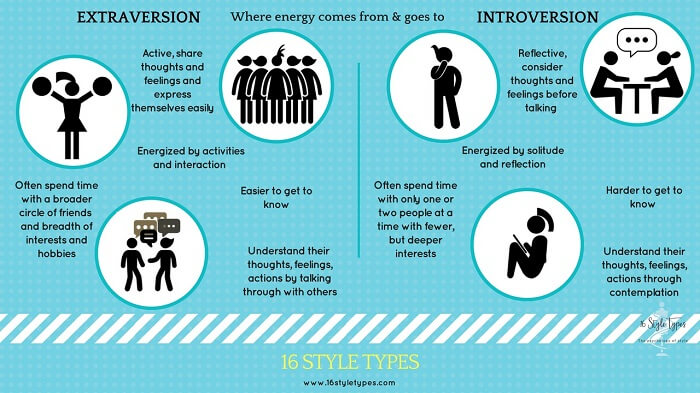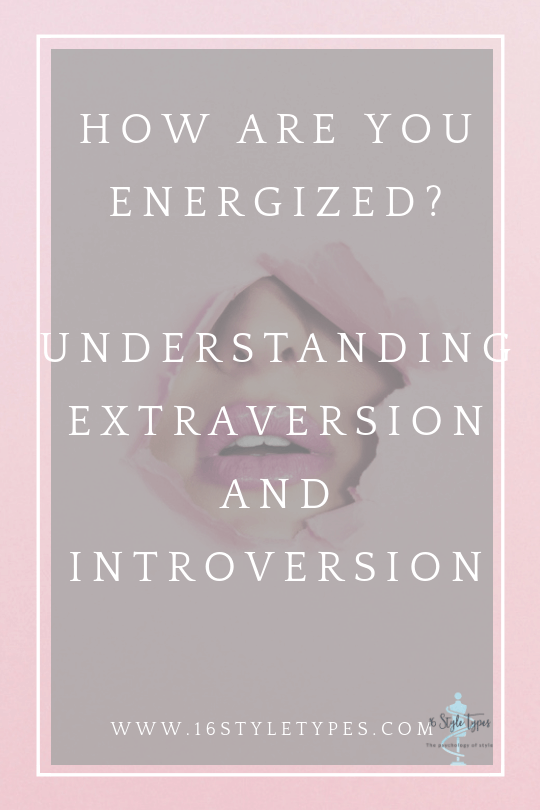What are the real difference between people who prefer Introversion and those who prefer Extraversion? If you are undecided which you are, how might you go about identifying the most accurate clues to help you discover your preference?
Watch The Video
In this video, Jill and Imogen discuss this most interesting aspect of Psychological Type – Introversion and Extraversion.
The content below is not an exact transcript of the video, but contains additional information.
Introversion and Extraversion are two terms in the Psychological Type vernacular that are possibly the most used in general parlance. Many people who aren’t familiar with the 16 Types have heard the terms, even if they aren’t quite sure what they mean exactly.
It’s hard to say whether they are more or less misunderstood than the other Psychological Type terms. But certainly it would be accurate to say that there are many myths and misconceptions surrounding Extraversion and Introversion.
What Is Introversion and Extraversion?
These two terms have a very specific meaning in the world of Psychological Type. They refer to energy, and specifically where our energy is sourced from – internally or externally — and the impact this energy-focus has on our choices and our state of being.
The theory of Psychological Type states that people are energized in one of two ways, through Extraversion or Introversion. This is the “dichotomy” approach that is the foundation of much Psychological Type education. As we’ll see, this is both a help and a hindrance to understanding Extraversion and Introversion.
Extraversion
People who prefer Extraversion are energized by action, interaction, and activity. It is not true that all Extraverts want to be the life of the party, and could talk the hind leg off a donkey (the first of many myths about Extraverts). It is true that Extraverts are energized by the people and things around them and find it stimulating to be “in the action”.
Extraverts often report that they prefer to work in settings where they can be part of a group or team. This does not mean they always want to be surrounded by constant chatter; Extraverts find “alone time” helpful for balance. But too much alone time is draining for Extraverts, who can find their energy dropping… and dropping … and dropping… if there isn’t enough opportunity for them to choose the interaction they most enjoy and find helpful.
Extraverts often find it helpful to process their thoughts by talking out loud and receiving input from others which they then use to modify their approach, plans, and ideas.
Introversion
People who prefer Introversion are energized by their inner world of thoughts, feelings, memories and ideas. It is not true that Introverts don’t enjoy being around people or being active (the first of many myths about Introverts). It is true that many Introverts find that being free to occupy their inner world is necessary for their wellbeing. Introverts often report drawing their energy from contemplation instead of from the activity itself, even if the activity is something they enjoy.
Introverts often find settings where they can work alone or one-on-one beneficial. This does not mean they don’t enjoy interactions with others, or find those interactions beneficial. But too much “people” or “activity” time is draining for Introverts, who can find their energy dropping… and dropping… and dropping… if there isn’t enough opportunity for them to be alone so they can access their inner world in a way they most enjoy and find helpful.
Introverts often find it helpful to prefer to process their thoughts silently and/or independently, sharing them only when they are satisfactorily formulated or finalized.
A Snapshot of Extraversion and Introversion
We created the following infographic as a way to summarize some key differences in those who prefer Introversion and those who prefer Extraversion.

Myths and Lies
Here’s a few myths and lies we’ve heard over the years. Some of these are the result of stories told in leadership and communication workshops in workplaces, where this concept is widely explored, and many myths shared (and hopefully debunked).
- Extraverts are the party girls and party boys. Not true. Some Extraverts love parties, others don’t find this particular kind of gathering their cup of tea. Extraverts are energized by activity and interaction – whether that’s a party or some other interaction or activity is a personal thing.
- Introverts don’t like people and are anti-social. Not true. Many Introverts have wide circles of acquaintance and enjoy being with others. Although many if not most Introverts would have a small, if not very small, circle of people they would call true and trusted friends.
- Extraverts “lie” or are unreliable – they come into a meeting with one point of view, then they ‘change’ it. Not true. Extraverts may come into a meeting or interaction with ideas or experiences to share, but it may be far from a finalized perspective or conclusion – they are actively seeking the input of others to come to a conclusion. This is the “thinking out loud” part that is so crucial to an Extravert coming to a clear understanding of what he or she thinks, feels, believes, and is then going to action.
- Introverts are secretive and/or intractable. Not true. Introverts find their inner world an interesting place to be, and want to be there – a lot. They often think and feel about things a great deal before they speak about them, sometimes choosing not to share. Sharing is often not necessary – it’s an optional extra, and often more for the benefit of others than the Introvert themselves. If you’ve spent as much time thinking and feeling about things as Introverts do before sharing, you often feel no further input is required.
- Extraverts hog the limelight and/or always want to be center stage. Not true. Some unaware Extraverts can find themselves “drawing focus” from any group they are part of and this can be annoying to others. These unaware Extraverts just know that talking with others is interesting and stimulating and want to be part of what’s going on. They can benefit from recognizing their Extraversion isn’t always a 100% positive experience for everybody all of the time.
- Introverts hate public speaking or being the center of attention. Not true. For a start, if you look at people who perform for a living, from actors to musicians, you’ll find a good smattering of Introverts. Public speaking is a skill, not a personality preference, and anybody can learn to be good at it. And just because you prefer Extraversion doesn’t immediately make you a good public speaker. Many Introverts have learned the skill of public speaking and are excellent at it, and enjoy sharing their knowledge and expertise.
These are a few of the more common myths and lies about Introversion and Extraversion, but it is by no means an exhaustive list. There seems no end to the myths and misconceptions that surround this aspect of personality!
Further Reading
You can read more about embracing your Style Type journey and dealing with potential triggers in this article.
It All Happened Travelling South
Two stories from Jill may help here. Both involve car trips that illustrate the stark difference that Introverts and Extraverts can have when ‘bumping up against’ one another.
In her corporate experience, Jill worked with a global professional services firm for many years, facilitating a two-day leadership program on self-awareness using Psychological Type as the foundation. One of the self-discovery explorations was around Extraversion-Introversion, which involved targeted activities followed by reflection time, then an open circle debrief with all participants.
In the first story, a senior executive with a preference for Extraversion recalled a 3-hour car trip she took with her new boyfriend, whom she was getting to know. This journey was excruciating for her, as her boyfriend hardly spoke at all. In her experience of his behaviour and this trip, his silence so concerned her that she asked if he was ill and needed to go to a hospital. This senior executive had the blinding flash of insight during Jill’s workshop that her boyfriend preferred Introversion. That he was probably enjoying the journey very much – he just didn’t need, or want, to talk all the way to their destination.
By the end of the trip, the Extraverted senior executive recalls being fatigued – so much time in a small space with someone who wasn’t talking had exhausted her. She was so tired from all that silence.
In the second story, a colleague who prefers Introversion recalls getting into a fairly heated exchange with her father-in-law whilst driving to dinner. Her father-in-law was impassioned on the topic and kept expounding his views to an increasingly silent audience. Jill’s Introverted colleague found this interaction so invasive that she later reported wanting to jump out of the car, even though it was moving at speed. She simply could not stand to be enclosed in a small space with someone who was talking and talking and talking, very animatedly, with no room for anyone else to speak, or simply for there to be silence for a beat.
By the end of the trip, the Introverted colleague recalls being overwhelmed – she felt almost disoriented from the experience. All that talking had worn her out.

It’s Not Happening in a Vacuum
Another important point to note is that Extraversion and Introversion are two concepts in a multi-concept theory of personality. The dynamic nature of Type tells us that Extraversion and Introversion are not separate concepts to be applied to a person without reference to other aspects of their Psychological Type.
A person’s personality or psychological make-up is not a jigsaw puzzle, to be put together a piece at a time with, voila!, the end results being a four-letter type code that describes who and what they are. That is a gross misrepresentation of how Type is intended to be applied to real human beings living in the real world, and is something of a Franksteinian approach to personality.
Type is multi-layered and the specific aspects of it are all connected. Introversion and Extraversion don’t exist in a vacuum – they are related to the other elements of Type, specifically the two middle letters (of Sensing, iNtuition, Thinking and Feeling).
So pulling Extraversion and Introversion “out” can be a helpful thing on one hand – for us to explore elements of this particular part of the theory, for example… and it can be a hindrance on another – as these terms do not exist on their own, but are part of what is referred to as “whole type”.
It’s All About Balance
One of the reasons we don’t use or subscribe to the term and concept of ambiversion has to do with balance. Extraverts require time alone (often considered Introvert territory) for balance. Introverts require time with others and being active (often considered Extravert territory) for balance.
No Extravert is always Extraverting – talking and being active, being around people and doing things. For psychological health, some time alone, some time to reflect and contemplate, is required. This alone and contemplation time is not the same for Extraverts as it is for Introverts. Introverts say they simply could not function at all without it, Extraverts report it being required for balance.
No Introvert is always Introverting – being alone with their thoughts, feelings, ideas, and memories. For psychological health, time with others and time doing active things is required. This active/people time is not the same for Introverts as it is for Extraverts. Extraverts say they would feel almost dead if they couldn’t be around others and if they couldn’t be actively involved, whilst Introverts report it being required for balance.
And finally, let’s cover off another important topic that always, but always, comes up. Can you be both Introverted and Extraverted? Are there such things as ambiverts (a term coined to described a person who is both Introverted and Extraverted at the same time)?
What about Ambiverts?
When you truly understand, at a deep and thorough level, the theory of Psychological Type and its beautiful and complex dynamic nature, you realize that not only is there no such thing as a person who prefers both Introversion and Extraversion, but there is no need for a term such as ambivert.
Here at 16 Style Types, we don’t use the term ambivert or believe in it. That’s because we use the deeper and more complex understanding of Type to inform our programs, our writing here on the Articles page, and everything else we do. Together, we have nearly 60 years experience working with this particular model of personality and personality development, including two of our team (Jane and Jill) who have served on the professional board which oversees the ethical use of Psychological Type, the Association of Psychological Type International.
So we understand Type at a level that many do not, and this is why we say there aren’t any ambiverts, nor do we need to categorize anybody as an ambivert.
If you are hellbent on using that term, then the answer is we are all ambiverts. Because we all use Extraversion and we all use Introversion, at least some of the time. We all need to be with other people and we all need to be alone. We all enjoy being active and we all benefit from contemplation.
It would be almost impossible to find a person who was a “pure” Extravert or a “pure” Introvert – such a person simply couldn’t function in any kind of healthy way in the world.
But how a person who prefers Introversion views, experiences and requires alone time is very different to how an Extravert views, experiences and requires it. Same for people time – an Extravert has a vastly different view, experience and need for it than does an Introvert. But we all need both. Just not in the same doses, in the same way, for the same reasons, to get the same outcome, or at the same time.
Further Reading
You can read more about the dynamic nature of psychological type in this article.
Who prefers wearing colour – Introverts or Extraverts? Find out here.
What’s Your Preference?
Understanding your preference for either Introversion or Extraversion can be hugely helpful. It can unlock a world of possibilities you were simply unaware existed, and can be a relationship-saver when it comes to interacting with others, especially those who are different to you.
When you discover your Style Type, you are taken through a self-discovery process which includes this important element of Extraversion and Introversion, debunking some common misconceptions and helping you discover for yourself what your true preference is around how you are energized, including what drains and fatigues you.
More Thoughts














